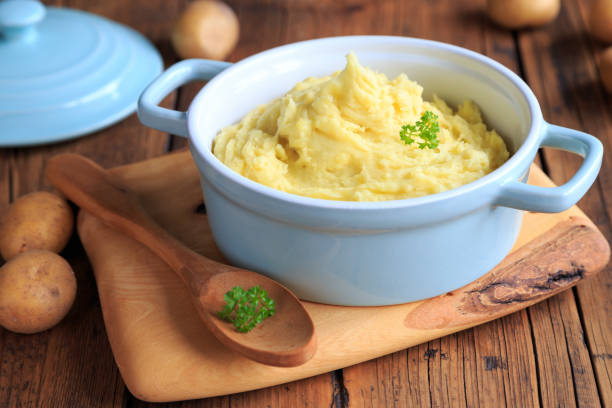Mashed potatoes, the epitome of comfort food, might seem like a straightforward dish to prepare. Boil, mash, and stir, right? However, delving into the world of mashed potatoes reveals a multitude of variations, from peeling to dairy choices and mashing techniques. With so many options, it’s like navigating a culinary labyrinth. But what if the way you cook your potatoes could dramatically impact the taste, texture, and overall experience of your beloved mashed potatoes?
That’s the question I set out to answer. In this experiment, I explored various cooking methods to see how each one affected the final outcome of mashed potatoes. To ensure a fair comparison, I used Yukon Gold potatoes known for their buttery flavor and lower starch content, which helps prevent a gluey texture. In each method, I followed a basic recipe, adding two tablespoons of melted butter, a quarter-cup of whole milk, and one teaspoon of kosher salt during mashing to maintain consistency. The butter was added before the milk, as suggested by cookbook author Diane Morgan.
All potatoes were hand-mashed with an OXO Smooth Potato Masher unless otherwise specified. Note that the times mentioned do not include potato peeling or cutting; they only account for cooking and mashing.
Method: Slow Cooker
Time: 3 hours, 35 minutes
The slow cooker method offers unmatched convenience. Simply toss potatoes and water into the slow cooker and let it work its magic while you attend to other tasks. However, my potatoes felt overcooked at three-and-a-half hours on the high setting, with an unsatisfactory flavor profile, leaning towards starchiness.
Rating: 6/10
Method: Steamed and Riced
Time: 25 minutes
Steaming potatoes is generally reserved for delicate vegetables, but it surprisingly yields quick results. After steaming, I ran the potatoes under cold water to remove excess starch, then used an OXO potato ricer before adding milk, butter, and salt. The texture was spot-on, but the flavor was lacking.
Rating: 6/10 (7/10 for a smooth mash)
Method: Sous Vide
Time: 40 minutes
Sous vide involves precise cooking in a sealed bag using controlled water temperatures. I used a Joule sous vide to cook the potatoes directly in a butter-milk mixture. While the method provided flavor concentration, it lacked moisture. Adjusting the butter and milk quantities may help, but scalability is limited.
Rating: 7/10
Method: No Boil
Time: 85+ minutes
Roasting potatoes is an acceptable alternative to boiling, offering the benefit of not requiring peeling. Although this method enhanced potato flavor, it was messy and inefficient when it came to extracting the flesh from the jackets.
Rating: 7/10
Method: Instant Pot
Time: 18 minutes (4 to pressurize, 8 to cook, 1 to vent, 5 to mash)
Pressure cooking, akin to steaming on steroids, provided both speed and quality. The potatoes turned out soft and smooth, with a fantastic flavor. This method allows for manual mashing or achieving a near-purée texture with an electric mixer.
Rating: 8/10
Method: Boiled, Hand-Mashed
Time: 38 minutes
Boiling and hand-mashing is the most traditional method, and it yielded impressive results. Cooking the potatoes until they were soft generated a delightful aroma and resulted in a dry mash with a mildly toasty flavor. Hand mashing left some texture, which I appreciated.
Rating: 9/10
Verdict
After thorough experimentation, the boiled and hand-mashed method emerged as the clear winner. With its simplicity, flavor, and delightful texture, it earned the top spot in my mashed potato quest. However, each method has its merits and might cater to different preferences. Whether you prioritize convenience, texture, or flavor, there’s a mashed potato method to suit your needs.
